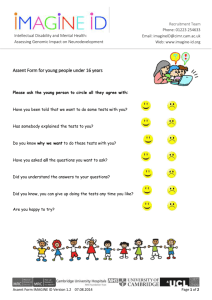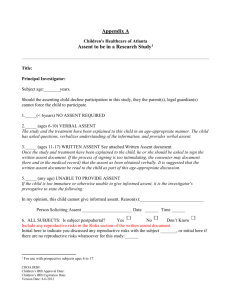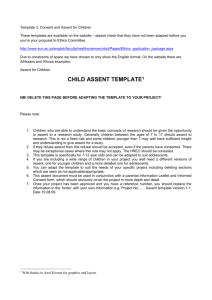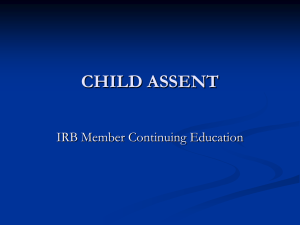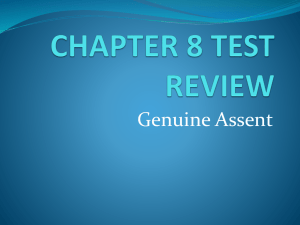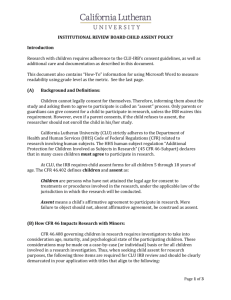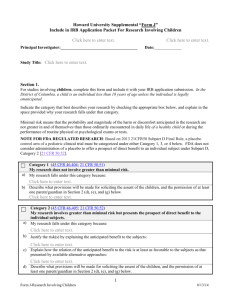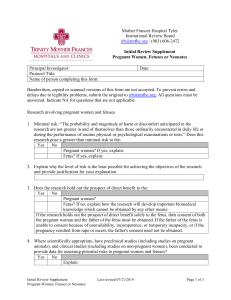Children Form - Dartmouth College
advertisement
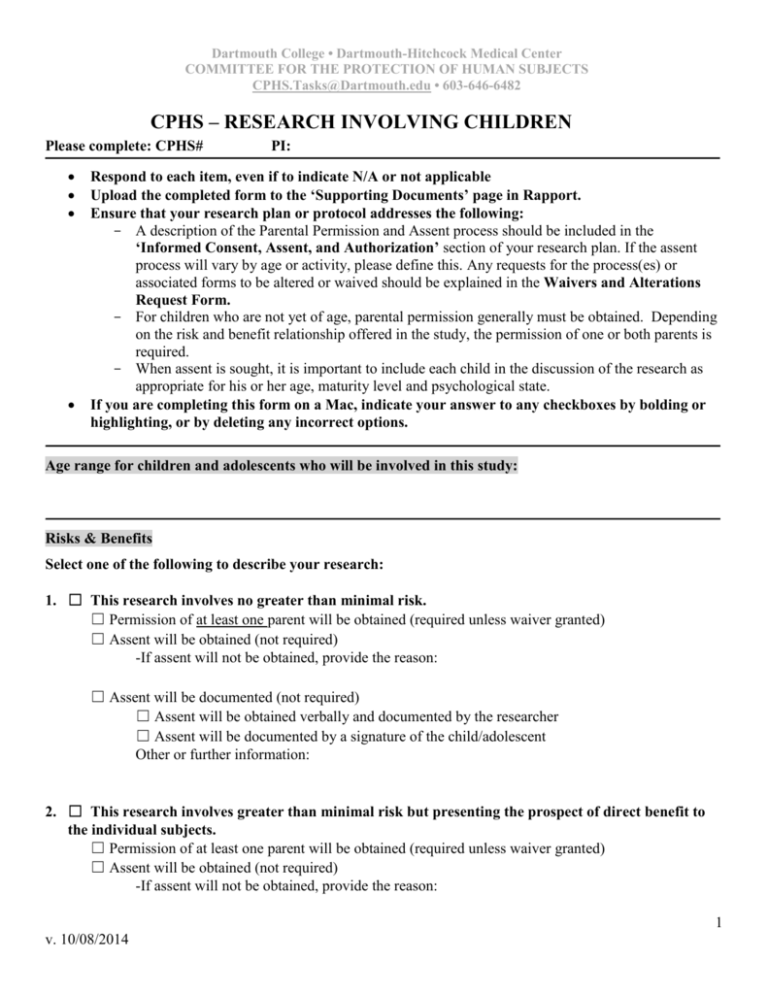
Dartmouth College • Dartmouth-Hitchcock Medical Center COMMITTEE FOR THE PROTECTION OF HUMAN SUBJECTS CPHS.Tasks@Dartmouth.edu • 603-646-6482 CPHS – RESEARCH INVOLVING CHILDREN Please complete: CPHS# PI: Respond to each item, even if to indicate N/A or not applicable Upload the completed form to the ‘Supporting Documents’ page in Rapport. Ensure that your research plan or protocol addresses the following: - A description of the Parental Permission and Assent process should be included in the ‘Informed Consent, Assent, and Authorization’ section of your research plan. If the assent process will vary by age or activity, please define this. Any requests for the process(es) or associated forms to be altered or waived should be explained in the Waivers and Alterations Request Form. - For children who are not yet of age, parental permission generally must be obtained. Depending on the risk and benefit relationship offered in the study, the permission of one or both parents is required. - When assent is sought, it is important to include each child in the discussion of the research as appropriate for his or her age, maturity level and psychological state. If you are completing this form on a Mac, indicate your answer to any checkboxes by bolding or highlighting, or by deleting any incorrect options. Age range for children and adolescents who will be involved in this study: Risks & Benefits Select one of the following to describe your research: 1. ☐ This research involves no greater than minimal risk. ☐ Permission of at least one parent will be obtained (required unless waiver granted) ☐ Assent will be obtained (not required) -If assent will not be obtained, provide the reason: ☐ Assent will be documented (not required) ☐ Assent will be obtained verbally and documented by the researcher ☐ Assent will be documented by a signature of the child/adolescent Other or further information: 2. ☐ This research involves greater than minimal risk but presenting the prospect of direct benefit to the individual subjects. ☐ Permission of at least one parent will be obtained (required unless waiver granted) ☐ Assent will be obtained (not required) -If assent will not be obtained, provide the reason: 1 v. 10/08/2014 ☐ Assent will be documented (not required) ☐ Assent will be obtained verbally and documented by the researcher ☐ Assent will be documented by a signature of the child/adolescent Other or further information: Address the following: Risks must be justified by anticipated benefit Anticipated benefit is at least as favorable as any alternatives 3. ☐ This research involves greater than minimal risk and no prospect of direct benefit to individual subjects, but likely to yield generalizable knowledge about the subject's disorder or condition. ☐ Permission of both parents will be obtained (required unless waiver granted) ☐ Assent will be obtained (required unless waiver granted) ☐ Assent will be documented (required unless waiver granted) ☐ Assent will be obtained verbally and documented by the researcher ☐ Assent will be documented by a signature of the child/adolescent Other or further information: Address the following: The risk is minor increase over minimal risk The intervention or procedure presents experiences to subjects that are reasonably commensurate with those inherent in their actual or expected medical, dental, psychological, social, or educational situations The anticipated knowledge that will be gained is of vital importance for the understanding or amelioration of the subjects' disorder or condition 4. ☐ This research is not otherwise approvable, but presents an opportunity to understand, prevent, or alleviate a serious problem affecting the health or welfare of children. ☐ Permission of both parents will be obtained (required unless waiver granted) ☐ Assent will be obtained (required unless waiver granted) ☐ Assent will be documented (required unless waiver granted) ☐ Assent will be obtained verbally and documented by the researcher in a note ☐ Assent will be documented by a signature of the child/adolescent Other or further information: 2 v. 10/08/2014 Note: in addition to this research being reviewed by the CPHS, research that falls into this category will also be referred to and reviewed by a National Advisory Board as well as made available for public review and comment prior to approval. Do you plan to recruit and enroll children who are wards of the State, or any other institution for this study? ☐ No ☐ Yes If Yes, provide a description of the following: Who will act as an advocate for the child(ren) Their background and experience to act in the best interest of the child(ren). Upload a letter of support/agreement from this advocate to the ‘Supporting Documents’ page in Rapport. Research involving Neonates: Regulatory Definitions: Neonate means a newborn. Nonviable neonate means a neonate after delivery that, although living, is not viable. Viable, as it pertains to the neonate, means being able, after delivery, to survive (given the benefit of available medical therapy) to the point of independently maintaining heartbeat and respiration. Have the neonates eligible for participation in this study been determined to be viable? ☐ No ☐ Yes ☐ Uncertain If yes, the neonates are subject to the regulations for the involvement of children in research studies. Please complete the Research Involving Children form. If uncertain or no, please answer the following questions: a. Where scientifically appropriate, have preclinical and clinical studies been conducted to provide data for assessing potential risks to neonates? ☐ No ☐ Yes Explain: b. The Principal Investigator assures that individuals engaged in the research will have no part in determining the viability of the neonate: ☐ No ☐ Yes Explain: c. Is the purpose of the research the development of important biomedical knowledge that cannot be 3 v. 10/08/2014 obtained by other means and will there be no added risk to the neonate as a result of the research? ☐ No ☐ Yes Explain: d. Will there be any added risk to the neonate resulting from the research? ☐ No ☐ Yes Explain: e. Does the research hold out the prospect of enhancing the probability of survival of the neonate to the point of viability, and is any risk the least possible for achieving that objective? ☐ No ☐ Yes Explain: f. Will legally effective informed consent from either parent* be obtained in the case of a neonate of uncertain viability? ☐ No ☐ Yes Explain: Respond to g through i only if the study involves neonates that have been determined to be nonviable independently from the investigator. g. Will legally effective informed consent from both parents* be obtained in the case of nonviable neonates? ☐ No ☐ Yes Explain: h. Will vital functions of the neonate be artificially maintained? ☐ No ☐ Yes Explain: i. Will the research terminate the heartbeat or respiration of the neonate? ☐ No ☐ Yes Explain: 4 v. 10/08/2014 *The legally effective informed consent of either parent may be waived because of unavailability, incompetence, or temporary incapacity, in which case the legally effective informed consent of either parent's legally authorized representative is obtained in accord with subpart A of CFR 45 part 46, except that the consent of the father or his legally authorized representative need not be obtained if the pregnancy resulted from rape or incest. 5 v. 10/08/2014
